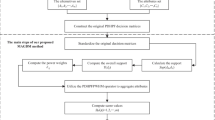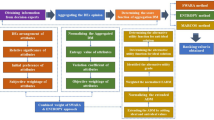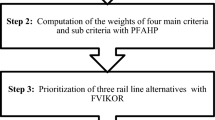Abstract
The hesitant Pythagorean fuzzy set (HPFS) is a tool for making decisions in the face of ambiguity. The concept of 2-tuple linguistic hesitant Pythagorean fuzzy sets (2TLHPSs) is proposed on the condition that uncertain information may not be adequately represented in the hesitant Pythagorean fuzzy environment. First, in this work, it is proposed that the concept of 2TLHPSs, which is based on hesitant 2-tuple linguistic variables and Pythagorean fuzzy variables, introduced the operational laws and the comparison rules of 2TLHPSs. Second, based on the classical multi-objective optimization by ratio analysis plus the full multiplicative form (MULTIMOORA) method, we propose a meta-synthesis approach (MSA) in the ranking aggregation method to consider the preference of decision points for three secondary rankings to avoid circular reasoning. This method used in the context of 2TLHPFS considers the weight in the model, and the parameter \(\varpi \) is quoted to reflect the preference of the decision-maker (DM) which improves the classical MULTIMOORA method. Finally, the practicability and reliability of our new method are explained and compared with other methods to reflect its flexibility by taking the location of the shared vehicle charging pile as an example.


Similar content being viewed by others
References
Altuntas S, Dereli T, Yilmaz MK (2015) Evaluation of excavator technologies: application of data fusion based multimoora methods. J Civ Eng Manag 21(8):977–997
Atanassov TK (1986) Intuitionistic fuzzy sets. Fuzzy Sets Syst 20(1):87–96
Beg I, Rashid T (2015) Hesitant 2-tuple linguistic information in multiple attributes group decision making. J Intell Fuzzy Syst 30(1):109–116
Brauers WK, Kazimieras ZE (2006) The MOORA method and its application to privatization in a transition economy. Control Cybern 35(2):445–469
Brauers WK, Zavadskas EK (2012) Robustness of MULTIMOORA: a method for multi-objective optimization. Informatica (Lith Acad Sci) 23(1):1–25
Brauers WK, Zavadskas E, Kazimieras (2010) Project management by multimoora as an instrument for transition economies. Technol Econ Dev Econ 16(1):5–24
Chen L, Xu HY, Ke GY (2021) A PROMETHEE II approach based on probabilistic hesitant fuzzy linguistic information with applications to multi-criteria group decision-making (ICSSE 2020). Int J Fuzzy Syst 23:1556–1580
Delgosha MS, Hajiheydari N (2020) Extended intuitionistic fuzzy VIKOR method in group decision making: the case of vendor selection decision. Int J Soc Sci Bus 14(5):351–358
Deng XM, Wei GW, Gao H, Wang J (2018) Models for safety assessment of construction project with some 2-tuple linguistic Pythagorean fuzzy Bonferroni mean operators. IEEE Access 99:52105–52137
Ejegwa PA (2019) Pythagorean fuzzy set and its application in career placements based on academic performance using max-min-max composition. Complex Intell Syst 5:165–175
Faizi S, Saabun W, Shaheen N, Rehman AU, Wtróbski J (2021) A novel multi-criteria group decision-making approach based on Bonferroni and Heronian mean operators under hesitant 2-tuple linguistic environment. Mathematics 9(13):1489. https://doi.org/10.3390/math9131489
Gao JW, Guo FJ, Li XZ, Huang X, Men HJ (2021) Risk assessment of offshore photovoltaic projects under probabilistic linguistic environment. Renew Energy 163:172–187
Garg H (2019) New logarithmic operational laws and their aggregation operators for Pythagorean fuzzy set and their applications. Int J Intell Syst 34(1):82–106
Gupta Pankaj, Mehlawat M. Kumar, Grover Nishtha, Pedrycz Witold (2018) Multi-attribute group decision making based on extended TOPSIS method under interval-valued intuitionistic fuzzy environment. Appl Soft Comput 69:554–567
Herrera F, Martinez L (2000) A 2-tuple fuzzy linguistic representation model for computing with words. IEEE Trans Fuzzy Syst 8(6):746–752
Jiao H (2020) Selection of resettlement site in reservoir construction using Pythagorean fuzzy MULTIMOORA multi-criteria decision-making method. J Coast Res 115(1):502–505
Karaca C, Ulutas A (2017) Supplier performance evaluation by using SWARA and MULTIMOORA. Econ Manag Econometr 12:137–151
Labella L, Dutta B, Martínez L (2021) An optimal best-worst prioritization method under a 2-tuple linguistic environment in decision making. Comput Ind Eng 155:107141. https://doi.org/10.1016/j.cie.2021.107141
Liu D, Huang A (2020) Consensus reaching process for fuzzy behavioral TOPSIS method with probabilistic linguistic q-rung orthopair fuzzy set based on correlation measure. Int J Intell Syst 35(3):1–35
Ma ZM, Xu ZS (2020) Computation of generalized linguistic term sets based on fuzzy logical algebras for multi-attribute decision making. Granul Comput 5(1):17–28
Rodriguez RM, Martinez L, Herrera F (2012) Hesitant fuzzy linguistic term sets for decision making. IEEE Trans Fuzzy Syst 20(1):109–119
Tehrim ST, Riaz M (2020) An interval-valued bipolar fuzzy linguistic VIKOR method using connection numbers of SPA theory and its application to decision support system. J Intell Fuzzy Syst 39:3931–3948
Torra V (2010) Hesitant fuzzy sets. Int J Intell Syst 25(6):529–539
Wan SP, Xu GL, Dong JY (2017) Supplier selection using ANP and ELECTRE II in interval 2-tuple linguistic environment. Inf Sci 385:19–38
Wan SP, Jin Z, Dong JY (2020) A new order relation for Pythagorean fuzzy numbers and application to multi-attribute group decision making. Knowl Inf Syst 62(2):751–785
Wang JQ, Li JJ (2009) The multi-criteria group decision making method based on multi-granularity intuitionistic two semantics. Sci Technol Inf 33(1):8–9
Wang HD, He SF, Pan XH (2018) A new bi-directional projection model based on Pythagorean uncertain linguistic variable. Information 9(5):104–116
Wang LN, Wang H, Xu ZS, Ren ZL (2019) The interval-valued hesitant Pythagorean fuzzy set and its applications with extended TOPSIS and Choquet integral-based method. Int J Intell Syst 34(6):1063–1085
Wang Y, Sun BZ, Zhang XR, Wang Q (2020) BWM and MULTIMOORA-based multigranulation sequential three-way decision model for multi-attribute group decision-making problem. Int J Approx Reason 125:169–186
Wu XL, Liao HC, Xu ZS, Hafezalkotob A, Herrera F (2018) Probabilistic linguistic MULTIMOORA: a multi-criteria decision making method based on the probabilistic linguistic expectation function and the improved Borda rule. IEEE Trans Fuzzy Syst 26:3688–3702
Xian SD, Sun WJ (2014) Fuzzy linguistic induced Euclidean OWA distance operator and its application in group linguistic decision making. Int J Intell Syst 29(5):478–491
Xian SD, Dong YF, Liu YB, Jing N (2018) A novel approach for linguistic group decision making based on generalized interval-valued intuitionistic fuzzy linguistic induced Hybrid operator and TOPSIS. Int J Intell Syst 33(2):288–314
Xue DF, Liu HC (2019) A new approach for emergency decision-making based on zero-sum game with Pythagorean fuzzy uncertain linguistic variables. Int J Intell Syst 34(7):1667–1684
Xue WT, Xu ZS, Zhang XL, Tian XL (2018) Pythagorean fuzzy LINMAP method based on the entropy theory for railway project investment decision making. Int J Intell Syst 33(1):93–125
Yager RR (2014) Pythagorean membership grades in multicriteria decision making. IEEE Trans Fuzzy Syst 22(4):958–965
Yang W, Pang Y, Shi J (2018) Linguistic hesitant intuitionistic fuzzy decision-making method based on VIKOR. Neural Comput Appl 29:613–626
Yin XP, Xu XH, Pan B (2021) Selection of strategy for large group emergency decision-making based on risk measurement. Reliab Eng Syst Saf 208:107325. https://doi.org/10.1016/j.ress.2020.107325
Zadeh LA (1965) Fuzzy sets. Inf Control 8(3):338–353
Zadeh LA (1975) The concept of a linguistic variable and its application to approximate reasoning-I. Inf Sci 8:199–249
Zhang D, Li Y, Wu C (2020) An extended TODIM method to rank products with online reviews under intuitionistic fuzzy environment. J Oper Res Soc 71(2):322–334
Zhang Q, Hu J, Feng J (2020) Multiple criteria decision making method based on the new similarity measures of Pythagorean fuzzy set. J Intell Fuzzy Syst 8:1–12
Zhu GN, Ma J, Hu J (2021) Evaluating biological inspiration for biologically inspired design: an integrated DEMATEL-MAIRCA based on fuzzy rough numbers. Int J Intell Syst 36(10):6032–6065
Acknowledgements
This work was supported by the Graduate Teaching Reform Research Program of Chongqing Municipal Education Commission (no. YJG212022) and Chongqing Research and Innovation Project of Graduate Students (no. CYS21326).
Author information
Authors and Affiliations
Corresponding author
Additional information
Communicated by Graçaliz Pereira Dimuro.
Publisher's Note
Springer Nature remains neutral with regard to jurisdictional claims in published maps and institutional affiliations.
Rights and permissions
About this article
Cite this article
Xian, S., Wan, W., Pan, H. et al. 2-tuple linguistic hesitant Pythagorean fuzzy MULTIMOORA with MSA and its application in the site selection problem of shared vehicle charging pile. Comp. Appl. Math. 41, 213 (2022). https://doi.org/10.1007/s40314-022-01913-3
Received:
Revised:
Accepted:
Published:
DOI: https://doi.org/10.1007/s40314-022-01913-3




